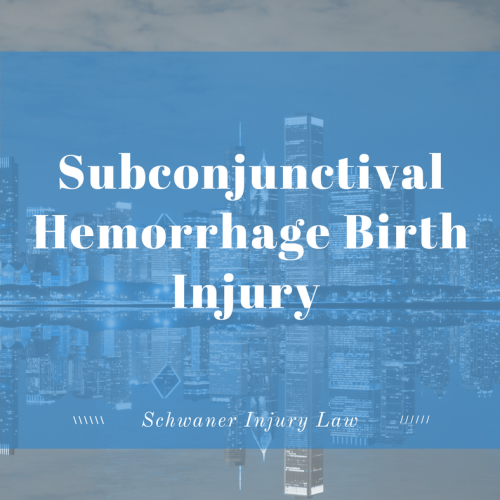
Subconjunctival Hemorrhage Birth Injury in Chicago, IL
Subconjunctival hemorrhage birth injuries occur as the small blood vessels below the baby’s eye in the area of the eye known as the conjunctiva rupture, most often due to the trauma of a complicated delivery.
The blood then gets trapped at the site of the rupture and appears as a red area in the white of the eye, also known as the sclera.
Subconjunctival hemorrhage is caused by either pressure from the birth canal – which is a risk factor when babies are too large for a comfortable delivery – or the misuse of assisted birthing devices such as forceps or vacuum extractors, both of which can cause the blood vessels to burst.
While subconjunctival hemorrhages usually clear up on their own, in some cases they can lead to potential eyesight problems that can be permanent.
What Causes Subconjunctival Hemorrhage Birth Injuries?
Table of Contents
While subconjunctival hemorrhages can be caused by the birth process itself, there are some situations where the problem is more likely to occur.
Some common causes of subconjunctival hemorrhages include:
- Pressure on the baby’s head due to the force of the mother’s contractions, most often during a prolonged, difficult delivery or a delivery which required the use of drugs to induce labor, which can cause stronger, more intense and more prolonged contractions.
- Rough or improper maneuvering during the manual repositioning of the baby’s head during a breech birth, which can put pressure on the blood vessels of the eye.
- The improper or unsafe use of assisted birthing devices, including forceps or vacuum extractors, which can also put pressure on the blood vessels of the eye.
- A side effect of resuscitation efforts immediately following birth.
Risk Factors for Subconjunctival Hemorrhage
Like other birth injuries, there are several risk factors for subconjunctival hemorrhage, including:
- Large babies. Babies with a birth weight of more than 8 pounds, 13 ounces.
- Premature births. Babies born before 37 weeks are more fragile and more easily injured, putting them at a higher risk of experiencing birth injuries.
- Cephalopelvic disproportion. If the size and shape of the mother’s pelvis is not large enough for the baby to be comfortably born through a vaginal birth, birth defects are more likely.
- Dystocia. A difficult labor or childbirth, including shoulder dystocia, during which the baby becomes lodged behind the pelvic bone, requiring the use of assisting birthing devices, makes birth injuries more of a risk factor.
- Prolonged labor. A long, difficult delivery can put a newborn at serious risk of a wide range of birth injuries, including subconjunctival hemorrhage.
- Abnormal birthing presentation. Breech births, as well as other abnormal birth positions, can put a baby at risk of injury, especially if doctors use unnecessary roughness to assist in the birth.
Symptoms of Subconjunctival Hemorrhage
A subconjunctival hemorrhage usually shows up as a bright or dark red patch in the whites of an infant’s eye. It usually appears either immediately following delivery or develops within a few hours after birth.
The redness may increase in the 24 hours following birth but usually will begin to recede after that, often turning yellow before the eye returns to normal.
The entire healing process should take between two to three weeks.
Treating Subconjunctival Hemorrhages
If an infant is born with a subconjunctival hemorrhage, your baby’s doctor will likely perform tests to make sure that there are not any accompanying, more serious, cranial damages associated with the hemorrhage that could lead to cerebral palsy or developmental delays.
Because the eye will be irritated, artificial tears may be prescribed to help treat the discomfort associated with the hemorrhage.
Complications Associated with Subconjunctival Hemorrhages
In most cases, an eye injury such as subconjunctival hemorrhage will heal on its own in less than a month, but because newborn health can change quickly, it is important that the eye is monitored for any unexpected changes that could reveal deeper, more serious injuries.
In some cases, subconjunctival hemorrhages don’t heal on their own, putting your baby at risk of a host of unwelcome outcomes including permanent eye damage including vision difficulties such as blurring or seeing double.
Subconjunctival hemorrhages may also be part of a larger, more serious injury with side effects that could be as serious as facial paralysis.
Proving Medical Negligence for Subconjunctival Hemorrhage
While medical negligence is often the reason for subconjunctival hemorrhage, proving that a healthcare provider was negligent requires evidence including establishing that the injured victim was owed a standard of care. (In the case of a birth injury, an obstetrician would be expected to provide reasonable care to any baby he or she was delivering.)
A case must also prove that careless or reckless action led to the injury, such as using undo force during the birth process. (Witnesses who were in the delivery room would be likely to help back up this claim.)
While a connection to the negligent actions must also directly linked to the injury, subconjunctival hemorrhage is most often caused by complicated births that could have been prevented.
In fact, most medical experts say that as many as half of all birth injuries including subconjunctival hemorrhage could have been avoided if the proper care had been taken during the birth process.
 In addition to causing the injury itself, failure to properly monitor a subconjunctival hemorrhage for additional complications – as well as the acts that led to too much pressure being put on the newborn’s head, causing the hemorrhage in the first place – could make your doctor, the hospital or other medical staff liable for your baby’s birth injuries.
In addition to causing the injury itself, failure to properly monitor a subconjunctival hemorrhage for additional complications – as well as the acts that led to too much pressure being put on the newborn’s head, causing the hemorrhage in the first place – could make your doctor, the hospital or other medical staff liable for your baby’s birth injuries.
What Should I Do If My Baby Suffered a Subconjunctival Hemorrhage?
If your baby has suffered permanent vision problems or other injuries due to a subconjunctival hemorrhage, an experienced birth injury attorneys can help.
Your initial consultation is free, and you won’t pay any fees until we win.












